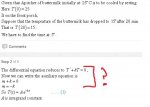I'm having trouble understanding how to solve the following problem:
A pitcher of buttermilk initially at 25 degrees Celsius is to be cooled by setting it on the front porch, where the temperature is 0 degrees Celsius. Suppose that the temperature of the buttermilk has dropped to 15 degrees Celsius after 20 min. When will it be at 5 degrees Celsius?
I actually have the steps required to solve the problem in front of me but I don't get how this step was made:

Why does the differential equation reduce to that? Is that a formula I should know? Also, what does it mean by "Auxiliary equation"?
A pitcher of buttermilk initially at 25 degrees Celsius is to be cooled by setting it on the front porch, where the temperature is 0 degrees Celsius. Suppose that the temperature of the buttermilk has dropped to 15 degrees Celsius after 20 min. When will it be at 5 degrees Celsius?
I actually have the steps required to solve the problem in front of me but I don't get how this step was made:

Why does the differential equation reduce to that? Is that a formula I should know? Also, what does it mean by "Auxiliary equation"?
